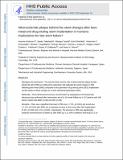| dc.contributor.author | Takahashi, Saeko | |
| dc.contributor.author | Tsuda, Masaya | |
| dc.contributor.author | Shishido, Koki | |
| dc.contributor.author | Mizuno, Shingo | |
| dc.contributor.author | Coskun, Ahmet U. | |
| dc.contributor.author | Saito, Shigeru | |
| dc.contributor.author | Feldman, Charles L. | |
| dc.contributor.author | Stone, Peter H. | |
| dc.contributor.author | Andreou, Ioannis | |
| dc.contributor.author | Antoniadis, Antonios | |
| dc.contributor.author | Papafaklis, Michail | |
| dc.contributor.author | Edelman, Elazer R | |
| dc.date.accessioned | 2017-12-18T14:28:49Z | |
| dc.date.available | 2017-12-18T14:28:49Z | |
| dc.date.issued | 2016-07 | |
| dc.date.submitted | 2016-05 | |
| dc.identifier.issn | 0021-9150 | |
| dc.identifier.uri | http://hdl.handle.net/1721.1/112774 | |
| dc.description.abstract | Background and aims The natural history and the role of atherosclerotic plaque located behind the stent (PBS) are still poorly understood. We evaluated the serial changes in PBS following bare-metal (BMS) compared to first-generation drug-eluting stent (DES) implantation and the impact of these changes on in-stent neointimal hyperplasia (NIH). Methods Three-dimensional coronary reconstruction by angiography and intravascular ultrasound was performed after intervention and at 6–10-month follow-up in 157 patients with 188 lesions treated with BMS (n = 89) and DES (n = 99). Results There was a significant decrease in PBS area (−7.2%; p < 0.001) and vessel area (−1.7%; p < 0.001) after BMS and a respective increase in both areas after DES implantation (6.1%; p < 0.001 and 4.1%; p < 0.001, respectively). The decrease in PBS area significantly predicted neointimal area at follow-up after BMS (β: 0.15; 95% confidence interval [CI]: 0.10–0.20, p < 0.001) and DES (β: 0.09; 95% CI: 0.07–0.11; p < 0.001) implantation. The decrease in PBS area was the most powerful predictor of significant NIH after BMS implantation (odds ratio: 1.13; 95% CI: 1.02–1.26; p = 0.02). Conclusions The decrease in PBS area after stent implantation is significantly associated with the magnitude of NIH development at follow-up. This finding raises the possibility of a communication between the lesion within the stent and the underlying native atherosclerotic plaque, and may have important implications regarding the pathobiology of in-stent restenosis and late/very late stent thrombosis. | en_US |
| dc.publisher | Elsevier | en_US |
| dc.relation.isversionof | http://dx.doi.org/10.1016/J.ATHEROSCLEROSIS.2016.07.914 | en_US |
| dc.rights | Creative Commons Attribution-NonCommercial-NoDerivs License | en_US |
| dc.rights.uri | http://creativecommons.org/licenses/by-nc-nd/4.0/ | en_US |
| dc.source | PMC | en_US |
| dc.title | Atherosclerotic plaque behind the stent changes after bare-metal and drug-eluting stent implantation in humans: Implications for late stent failure? | en_US |
| dc.type | Article | en_US |
| dc.identifier.citation | Andreou, Ioannis et al. “Atherosclerotic Plaque Behind the Stent Changes after Bare-Metal and Drug-Eluting Stent Implantation in Humans: Implications for Late Stent Failure?” Atherosclerosis 252 (September 2016): 9–14 © 2016 Elsevier Ireland Ltd | en_US |
| dc.contributor.department | Massachusetts Institute of Technology. Institute for Medical Engineering & Science | en_US |
| dc.contributor.mitauthor | Andreou, Ioannis | |
| dc.contributor.mitauthor | Antoniadis, Antonios | |
| dc.contributor.mitauthor | Papafaklis, Michail | |
| dc.contributor.mitauthor | Edelman, Elazer R | |
| dc.relation.journal | Atherosclerosis | en_US |
| dc.eprint.version | Author's final manuscript | en_US |
| dc.type.uri | http://purl.org/eprint/type/JournalArticle | en_US |
| eprint.status | http://purl.org/eprint/status/PeerReviewed | en_US |
| dc.date.updated | 2017-12-14T19:13:57Z | |
| dspace.orderedauthors | Andreou, Ioannis; Takahashi, Saeko; Tsuda, Masaya; Shishido, Koki; Antoniadis, Antonios P.; Papafaklis, Michail I.; Mizuno, Shingo; Coskun, Ahmet U.; Saito, Shigeru; Feldman, Charles L.; Edelman, Elazer R.; Stone, Peter H. | en_US |
| dspace.embargo.terms | N | en_US |
| dc.identifier.orcid | https://orcid.org/0000-0001-9373-705X | |
| dc.identifier.orcid | https://orcid.org/0000-0002-5646-0378 | |
| dc.identifier.orcid | https://orcid.org/0000-0002-7832-7156 | |
| mit.license | PUBLISHER_CC | en_US |
